Workspace
The clothes we wear––the visage we reveal––for the world to see arguably has a two-fold purpose. Firstly, it is our personal billboard; we project the summarized self as outerwear of sometimes many layers so the world outside can actually read us as easily as possible, no matter how much we may struggle against that fact. The problem comes down to how people interpret such language.
Secondly, it is our armor. The clothing we wear––with the image we project––is protection against the soft inner core of our being. A lot of effort may go into the creation and projection of that persona and diamond-sharp aesthetic definition of ourselves as mode of expression, but doing so simultaneously grants us protection. Beneath it all, our complicated, interwoven rat kings of experiences, neuroses, prejudices, and talent are vulnerable and sore; too raw for constant exposure and interaction. I argue this is true for everybody, to an extent. Some are more vulnerable than others, so we wear more layers––figuratively or literally––than others, but we all protect ourselves to some degree because, at the baseline, we all have things we need to do and can’t always be bothered to stop and explain and/or defend ourselves.
For the solitary creative, the inverse is true for our workspaces. For me, my office is a chrysalis inside of which I can metaphorically disrobe because I am surrounded by “me.” It’s the compartmentalization of the “me” in the area that allows for focus and work; I get to hang “myself” up on a hanger through the arrangement of inspiration, nostalgia, and tools of my trades. These disparate tapestries signal safety to me, so I can just concentrate on what needs to get done. The office is, in many ways, a more careful construct than my outward presentation (for some, this is not a surprise; nor is it a larger effort), because here I need to actually produce.
However, being a creative person, I often feel like an inadequate impostor.
Inspiration comes from any angle since many pieces go into inspiration and production of creative output, and one piece of inspiration that I can usually count on getting me going is seeing the workspaces of creative people. I pour over the pictures and revel in the messes (or cleanliness) that people I admire and respect create within.
Because of that––and because people have asked me over the years what my creative space looks like––I figured, because of a recent cleaning, to share my office as it has been for the last few years.
The first bookshelf coming into the room holds all my comics/graphic novels, art books, select fiction, and sundry other––mostly oversized––books (and CDs, apparently). And, yes, Transformers (this bookcase is devoted to stars from the 1986 animated film, but whatever). The intended purpose for this bookcase being so close to my drawing table (out of view, to the left) is that these would be the items which would work best as reference or inspiration while actually making comics (the comics and stuff, not the Transformers). The idea is also that all inspirational/referential art on this shelf would be rotated out with time, and it’s been a refreshing experience to got through everything and ask how much each item would really push me forward on a project. Lastly, a print reproduction of the one-sheet from one of my most favorite movies, Point Blank, peeks out from behind the bookcase on the right.
Continuing left, we come to the drawing portion of the room. The art table belonged to my grandfather, a commercial artist in the Mad Men-iest sense of the word (though he worked for a vitamin company and not an ad agency). The board itself is not original, but it gets the job done. I’ve surrounded the table with inspirational work, naturally. Clockwise from the top left is a Prophet print by Giannis Milonogiannis, a painting based off a short story I wrote called “Hunter’s Moon” done for my be Josh Tobey. To the right is, on top, a painting of the “Fighter” game sprite from the original Final Fantasy, and beneath it is a ballpoint pen background drawing for an animation project, both done by Josh Tobey. Next is an original page from Prophet #23 by Simon Roy. To the left is a picture from the Mad Max Trilogy Blu-Ray tin above a printout of Wally Wood’s famous “22 Panels That Always Work” schematic. These are followed by a Vampire Hunter D print by Melissa Pagluica (read her amazing webcomic, Above the Clouds, right now). And, lastly, is a copy of the third-year anniversary print I did for Eben07. The little magnetized dry-erase board is the vessel on which I travel the river of life, and use it for any immediate purpose. As of this photograph, it’s supporting the grading breakdown for my Fall 2015 classes, but often also sports hastily written to-do lists or problem-posing questions about story beats, etc. It really is half of the heartbeat of how I work (followed by the corkboard, to be featured later).
The mug full of stuff is an original work by Josh Tobey as well; it’s got a big nose on the front of it, which makes it the best thing ever made.
And a replica 1860 Colt Army is a thing, too.
The computer workstation is a Mac Pro from a hundred years ago. The vertical display is used for writing, in order to see as much text as possible, which is nice. Underneath the cinema display, tucked away, is my Wacom Intuos3 tablet, which I think is all the art stuff I have at my computer. It, too, is surrounded by inspirational art. From the left, a Rocketeer print signed by the late creator Dave Stevens followed by a goofy Optimus Prime parody print by artist Tim Doyle. Then is a print of the label from Sierra Nevada’s “Ruthless Rye” IPA. Then is the five-year anniversary print I did for Eben07 above a Long John print that was printed onto a sheet of tin by RA Comics Direct.
As cool as those things are, the desk is falling apart, and surely will do so at a moment’s notice. The keyboard drawer regularly falls to the floor if bumped. Despite knowing that, it’s still full of stuff. Also, an Epiphone Wildkat to the right.
Rounding out the tourism the last corner of the room, which features my poorly organized bookshelf with a bunch of Transformers on it. This is where I keep the fiction––history, mostly––as well as my manga collections. The top shelf is dedicated to translations of The Iliad and The Odyssey; I try to collect as many different versions as possible and speak to my secret desire to become a Classicist.
The bookshelf does have some original art, though; first is an ink and marker drawing by Mark Rudolph recreating a panel from his comic adaptation of the H.P. Lovecraft short story, “Dagon.” Next to that is a great silhouette painting of Wolverine by Seattle artist whose name I can’t read from the back, and I’m ashamed to admit that.
The main thing to note is the huge cork board where, right now, I post pages in pairs so I can see how they read. I draw my layouts in two-page increments and actually hanging them up to view them in final form really helps me see how the story is progressing and, next to my computer, focus the dialogue. When not covered in finished pages, it is a kind of tone chart for whatever I’m working on. I hang upon it images and texts that evoke the emotions and atmosphere of whatever I’m working on at the time. Usually, this means a bunch of shoddy printouts from stuff I find on the internet; it has, at different times, housed printouts of paintings, character/clothing reference, animal reference, song lyrics, sketches, and scripts, among myriad other things. It was the last major piece to be added to the room and really helped productivity “click” in my brain and I recommend anybody to go find the largest corkboard available and hang it in the office as soon as possible.
Also, a Frankenstein Fender Stratocaster on a Fender Hot Rod DeVille 212.
And that is how my things look. If you want to imagine the workspace in action, imagine all of this but with paper everywhere and at least two mugs either full, or half-full, of tea on each of the desks and you’ll have it quite right. And, in a sense, you have seen “me” inasmuch as “D. Bethel” can be broken into pieces and given the space to stare at anybody in the room. These things, though nerdy, I would argue keep it from being the cliche “man cave” and are more the necessary pieces for me to actually sit down and work. This isn’t blatant nostalgia––though nostalgia is, indeed present––and it isn’t a sanctuary from the real world; the room is a construct that provides the necessary blend of expression and protection so I can do my best work without worry or hesitancy. You want to know about Long John? Check out this room. You want to know about me? Look at this room. You want to know about what I’ll be doing in the future? Look at this room. It is me and it is my work; it will change yet it will always be me. As it should be.

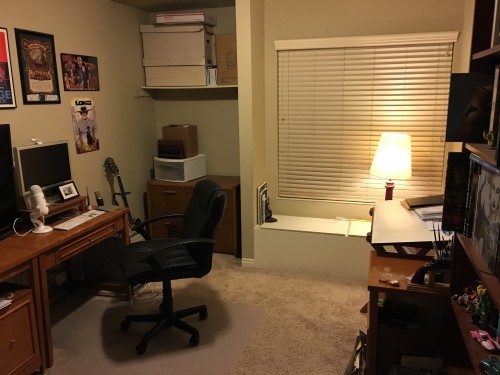
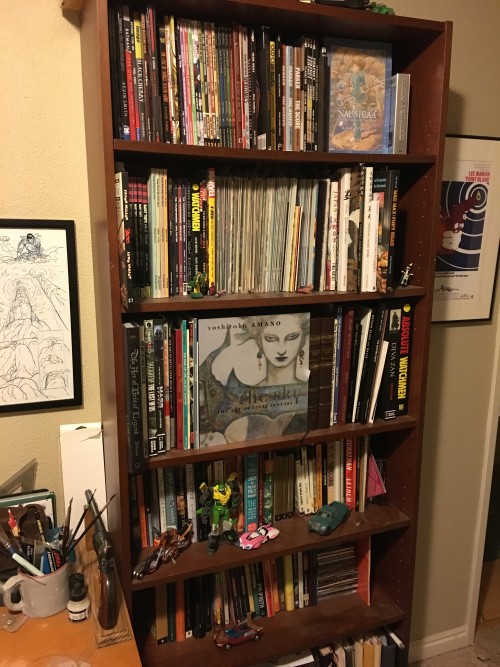
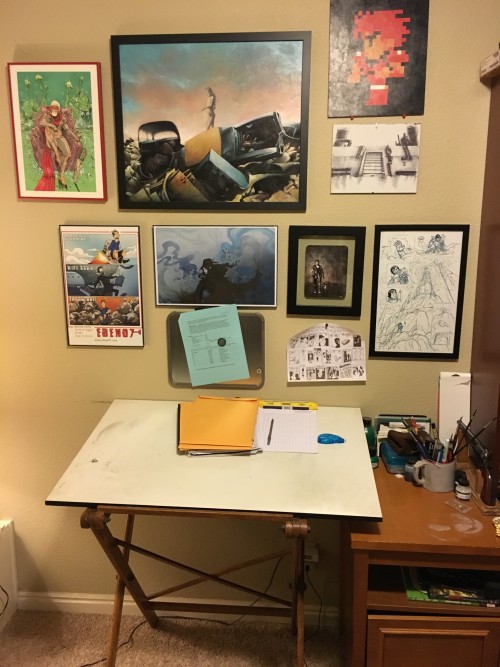
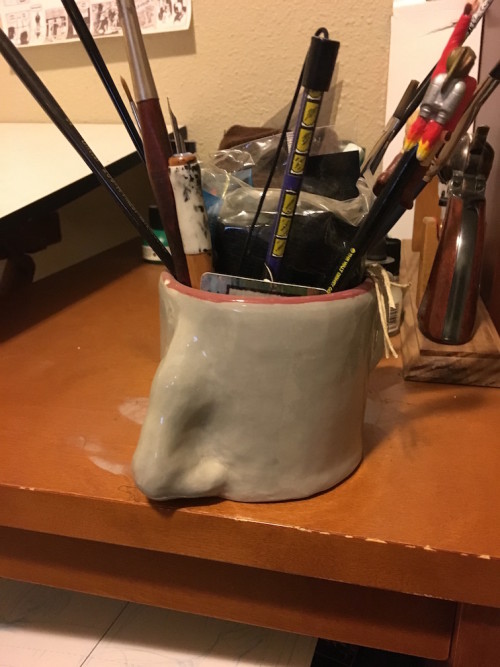
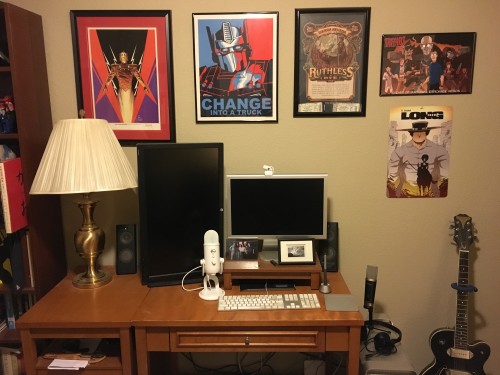
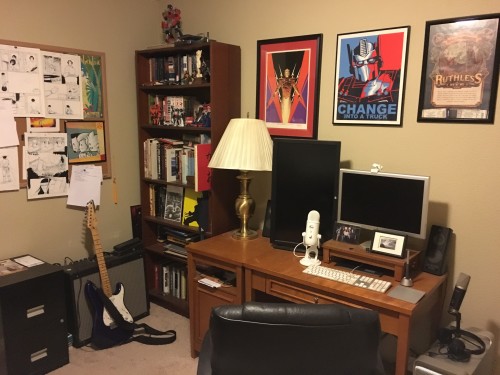
Love it. This is where the magic happens.